2015 Peugeot 208 tow
[x] Cancel search: towPage 98 of 341
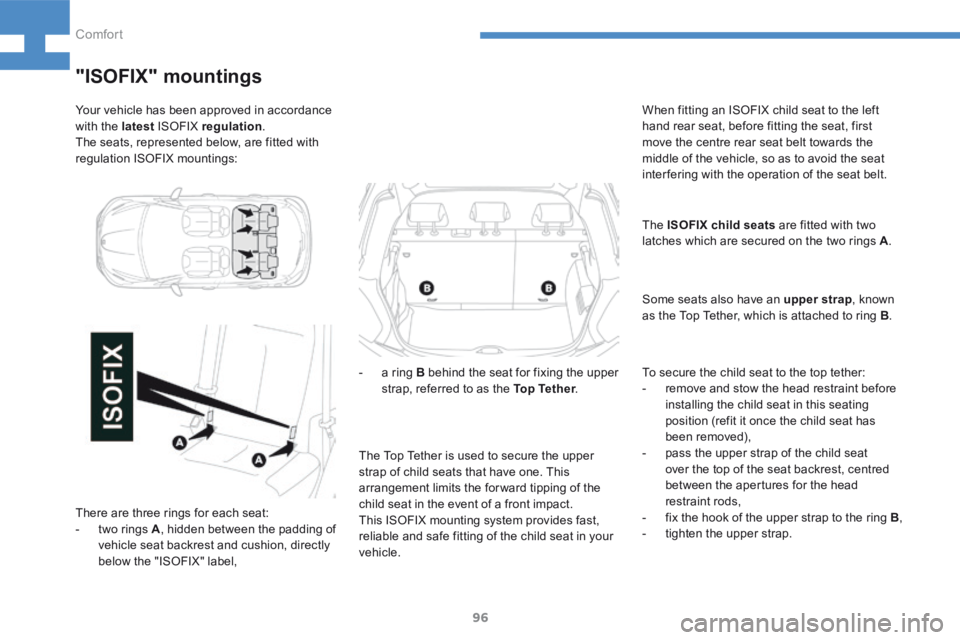
96
208_en_Chap04_confort_ed01-2015
Your vehicle has been approved in accordance
with the latest ISOFIX regulation .
The seats, represented below, are fitted with
regulation ISOFIX mountings:
"ISOFIX" mountings
There are three rings for each seat:
- two rings A , hidden between the padding of
vehicle seat backrest and cushion, directly
below the "ISOFIX" label, The Top Tether is used to secure the upper
strap of child seats that have one. This
arrangement limits the forward tipping of the
child seat in the event of a front impact.
This ISOFIX mounting system provides fast,
reliable and safe fitting of the child seat in your
vehicle. -
a ring B behind the seat for fixing the upper
strap, referred to as the Top Tether .When fitting an ISOFIX child seat to the left
hand rear seat, before fitting the seat, first
move the centre rear seat belt towards the
middle of the vehicle, so as to avoid the seat
interfering with the operation of the seat belt.
The ISOFIX child seats are fitted with two
latches which are secured on the two rings A
.
Some seats also have an upper strap , known
as the Top Tether, which is attached to ring B .
To secure the child seat to the top tether:
- remove and stow the head restraint before
installing the child seat in this seating
position (refit it once the child seat has
been removed),
- pass the upper strap of the child seat
over the top of the seat backrest, centred
between the apertures for the head
restraint rods,
- fix the hook of the upper strap to the ring B ,
- tighten the upper strap.
Comfort
Page 101 of 341
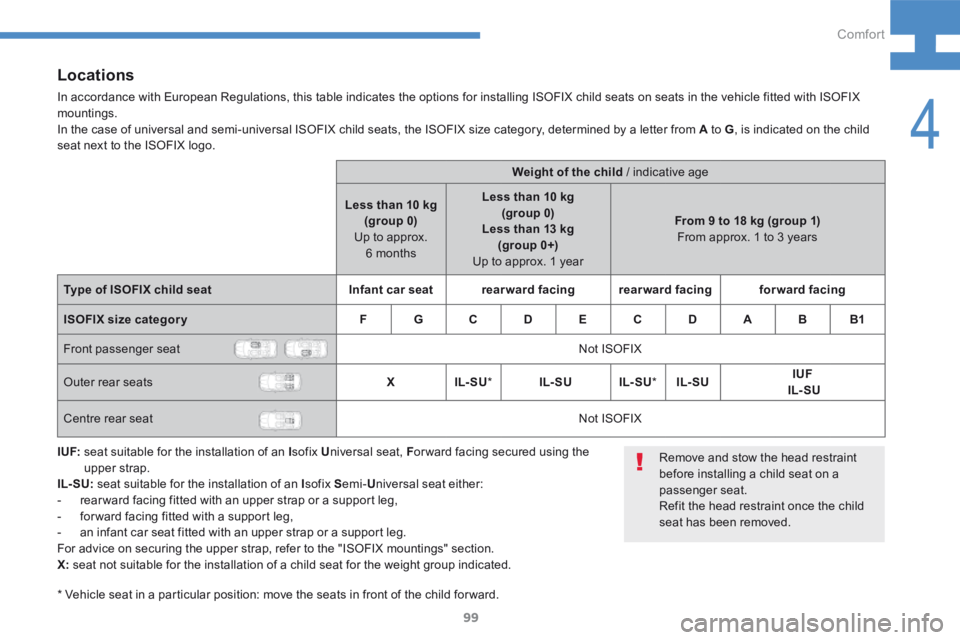
99
208_en_Chap04_confort_ed01-2015
Locations
In accordance with European Regulations, this table indicates the options for installing ISOFIX child seats on seats in the vehicle fitted with ISOFIX
mountings.
In the case of universal and semi-universal ISOFIX child seats, the ISOFIX size category, determined by a letter from A to G, is indicated on the child
seat next to the ISOFIX logo.
Weight of the child / indicative age
Less than 10 kg (group 0)
Up to approx. 6 months Less than 10 kg
(group 0)
Less than 13 kg (group 0+)
Up to approx. 1 year From 9 to 18 kg (group 1)
From approx. 1 to 3 years
Type of ISOFIX child seat Infant car seatrearward facing rearward facing forward facing
ISOFIX size categor y FG CD EC DABB1
Front passenger seat Not ISOFIX
Outer rear seats XIL- SU* IL- SU IL- SU*IL- SU IUF
IL- SU
Centre rear seat Not ISOFIX
I UF: seat suitable for the installation of an I sofix Universal seat, F or ward facing secured using the
upper strap.
IL- SU: seat suitable for the installation of an I sofix Semi-Universal seat either:
- rear ward facing fitted with an upper strap or a support leg,
- for ward facing fitted with a support leg,
- an infant car seat fitted with an upper strap or a support leg.
For advice on securing the upper strap, refer to the "ISOFIX mountings" section.
X: seat not suitable for the installation of a child seat for the weight group indicated.
* Vehicle seat in a particular position: move the seats in front of the child for ward. Remove and stow the head restraint
before installing a child seat on a
passenger seat.
Refit the head restraint once the child
seat has been removed.
4
Comfort
Page 106 of 341
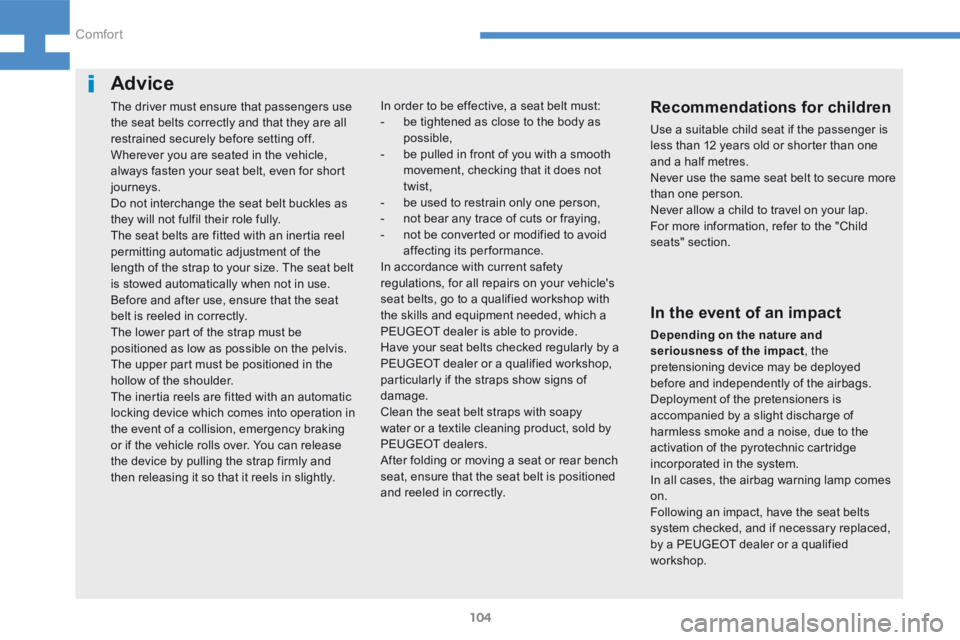
104
208_en_Chap04_confort_ed01-2015
Advice
The driver must ensure that passengers use
the seat belts correctly and that they are all
restrained securely before setting off.
Wherever you are seated in the vehicle,
always fasten your seat belt, even for short
journeys.
Do not interchange the seat belt buckles as
they will not fulfil their role fully.
The seat belts are fitted with an inertia reel
permitting automatic adjustment of the
length of the strap to your size. The seat belt
is stowed automatically when not in use.
Before and after use, ensure that the seat
belt is reeled in correctly.
The lower part of the strap must be
positioned as low as possible on the pelvis.
The upper part must be positioned in the
hollow of the shoulder.
The inertia reels are fitted with an automatic
locking device which comes into operation in
the event of a collision, emergency braking
or if the vehicle rolls over. You can release
the device by pulling the strap firmly and
then releasing it so that it reels in slightly.Recommendations for children
Use a suitable child seat if the passenger is
less than 12 years old or shorter than one
and a half metres.
Never use the same seat belt to secure more
than one person.
Never allow a child to travel on your lap.
For more information, refer to the "Child
seats" section.
In order to be effective, a seat belt must:
-
be tightened as close to the body as
possible,
- be pulled in front of you with a smooth
movement, checking that it does not
twist,
- be used to restrain only one person,
- not bear any trace of cuts or fraying,
- not be converted or modified to avoid
affecting its performance.
In accordance with current safety
regulations, for all repairs on your vehicle's
seat belts, go to a qualified workshop with
the skills and equipment needed, which a
PEUGEOT dealer is able to provide.
Have your seat belts checked regularly by a
PEUGEOT dealer or a qualified workshop,
particularly if the straps show signs of
damage.
Clean the seat belt straps with soapy
water or a textile cleaning product, sold by
PEUGEOT dealers.
After folding or moving a seat or rear bench
seat, ensure that the seat belt is positioned
and reeled in correctly.
In the event of an impact
Depending on the nature and
seriousness of the impact , the
pretensioning device may be deployed
before and independently of the airbags.
Deployment of the pretensioners is
accompanied by a slight discharge of
harmless smoke and a noise, due to the
activation of the pyrotechnic cartridge
incorporated in the system.
In all cases, the airbag warning lamp comes
on.
Following an impact, have the seat belts
system checked, and if necessary replaced,
by a PEUGEOT dealer or a qualified
workshop.
Comfort
Page 107 of 341
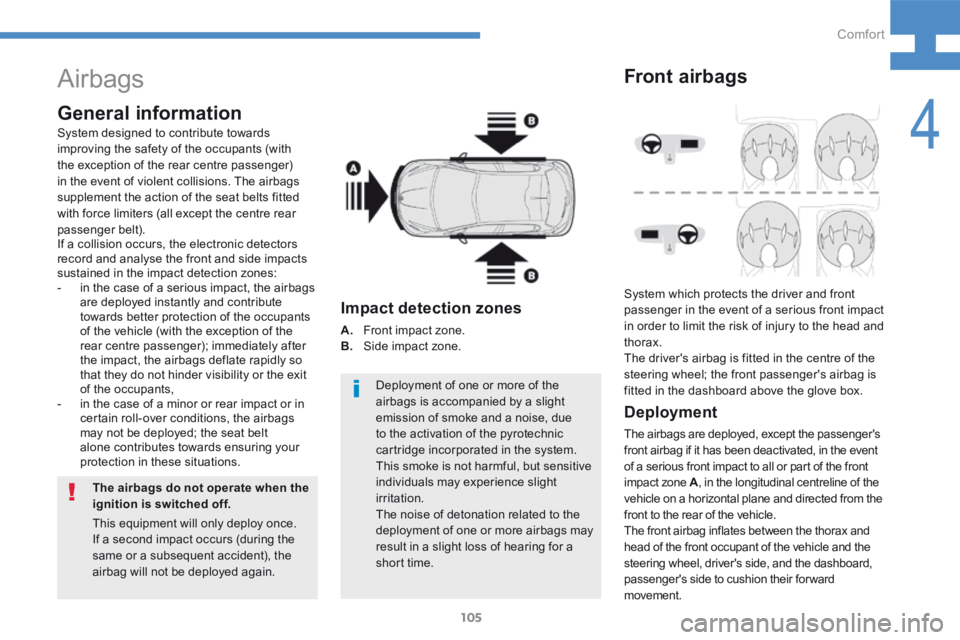
105
208_en_Chap04_confort_ed01-2015
Airbags
General information
The airbags do not operate when the
ignition is switched off.Deployment of one or more of the
airbags is accompanied by a slight
emission of smoke and a noise, due
to the activation of the pyrotechnic
cartridge incorporated in the system.
This smoke is not harmful, but sensitive
individuals may experience slight
irritation.
The noise of detonation related to the
deployment of one or more airbags may
result in a slight loss of hearing for a
short time.
Impact detection zones
A.
Front impact zone.
B. Side impact zone.
Front airbags
Deployment
The airbags are deployed, except the passenger's
front airbag if it has been deactivated, in the event
of a serious front impact to all or part of the front
impact zone A, in the longitudinal centreline of the
vehicle on a horizontal plane and directed from the
front to the rear of the vehicle.
The front airbag inflates between the thorax and
head of the front occupant of the vehicle and the
steering wheel, driver's side, and the dashboard,
passenger's side to cushion their forward
movement. System which protects the driver and front
passenger in the event of a serious front impact
in order to limit the risk of injury to the head and
thorax.
The driver's airbag is fitted in the centre of the
steering wheel; the front passenger's airbag is
fitted in the dashboard above the glove box.
This equipment will only deploy once.
If a second impact occurs (during the
same or a subsequent accident), the
airbag will not be deployed again.
System designed to contribute towards
improving the safety of the occupants (with
the exception of the rear centre passenger)
in the event of violent collisions. The airbags
supplement the action of the seat belts fitted
with force limiters (all except the centre rear
passenger belt).
If a collision occurs, the electronic detectors
record and analyse the front and side impacts
sustained in the impact detection zones:
-
in the case of a serious impact, the airbags
are deployed instantly and contribute
towards better protection of the occupants
of the vehicle (with the exception of the
rear centre passenger); immediately after
the impact, the airbags deflate rapidly so
that they do not hinder visibility or the exit
of the occupants,
- in the case of a minor or rear impact or in
certain roll-over conditions, the airbags
may not be deployed; the seat belt
alone contributes towards ensuring your
protection in these situations.
4
Comfort
Page 109 of 341
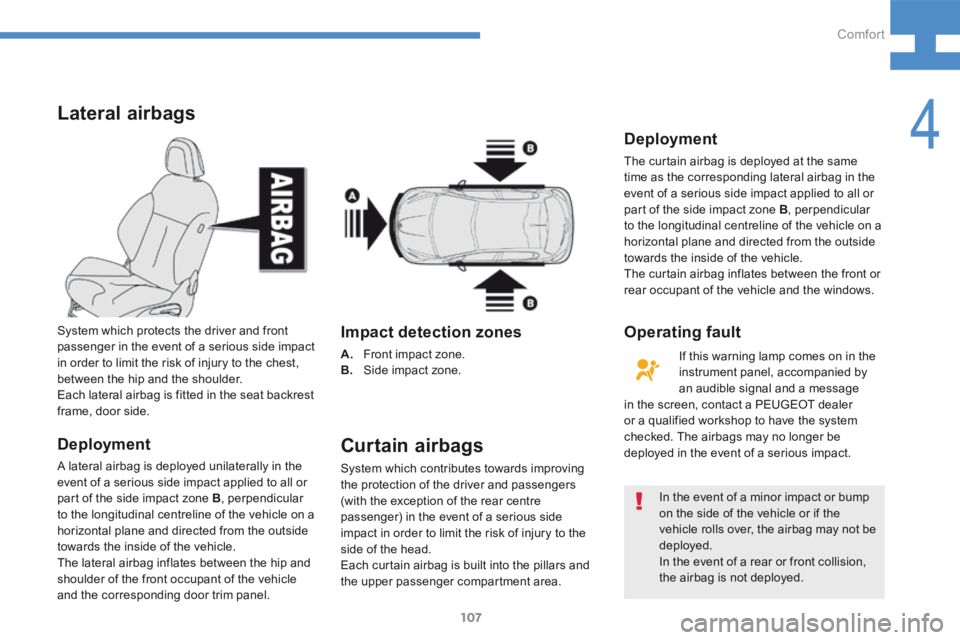
107
208_en_Chap04_confort_ed01-2015
Lateral airbags
Deployment
A lateral airbag is deployed unilaterally in the
event of a serious side impact applied to all or
part of the side impact zone B, perpendicular
to the longitudinal centreline of the vehicle on a
horizontal plane and directed from the outside
towards the inside of the vehicle.
The lateral airbag inflates between the hip and
shoulder of the front occupant of the vehicle
and the corresponding door trim panel. System which protects the driver and front
passenger in the event of a serious side impact
in order to limit the risk of injury to the chest,
between the hip and the shoulder.
Each lateral airbag is fitted in the seat backrest
frame, door side.
Impact detection zones
A. Front impact zone.
B. Side impact zone.
Curtain airbags
System which contributes towards improving
the protection of the driver and passengers
(with the exception of the rear centre
passenger) in the event of a serious side
impact in order to limit the risk of injury to the
side of the head.
Each curtain airbag is built into the pillars and
the upper passenger compartment area. In the event of a minor impact or bump
on the side of the vehicle or if the
vehicle rolls over, the airbag may not be
deployed.
In the event of a rear or front collision,
the airbag is not deployed.
Deployment
The curtain airbag is deployed at the same
time as the corresponding lateral airbag in the
event of a serious side impact applied to all or
part of the side impact zone B
, perpendicular
to the longitudinal centreline of the vehicle on a
horizontal plane and directed from the outside
towards the inside of the vehicle.
The curtain airbag inflates between the front or
rear occupant of the vehicle and the windows.
If this warning lamp comes on in the
instrument panel, accompanied by
an audible signal and a message
in the screen, contact a PEUGEOT dealer
or a qualified workshop to have the system
checked. The airbags may no longer be
deployed in the event of a serious impact.
Operating fault
4
Comfort
Page 122 of 341
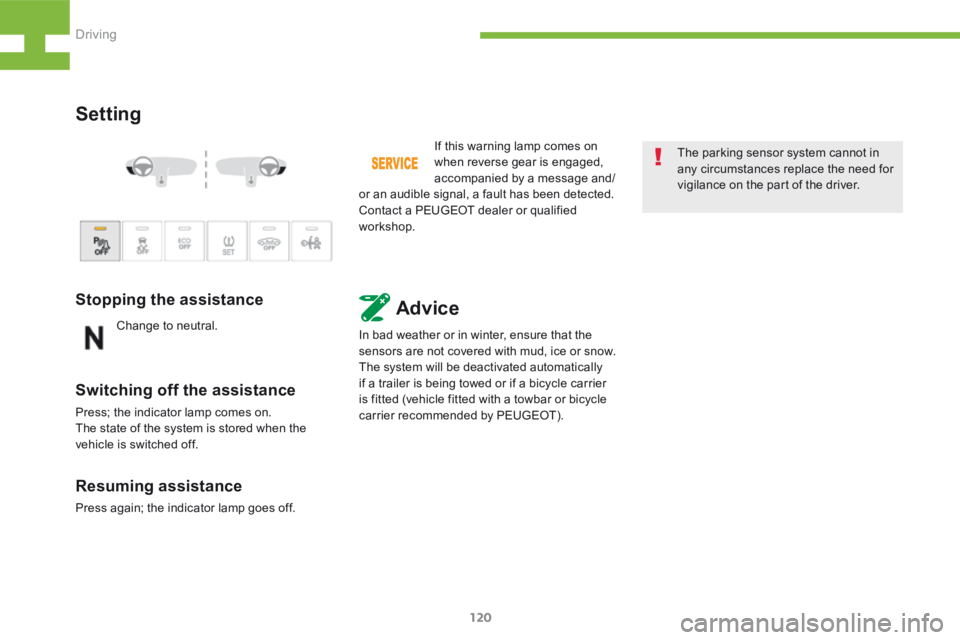
120
208_en_Chap05_conduite_ed01-2015
Setting
Stopping the assistance
Switching off the assistance
Press; the indicator lamp comes on.
The state of the system is stored when the
vehicle is switched off.
Resuming assistance
Press again; the indicator lamp goes off.
AdviceChange to neutral.In bad weather or in winter, ensure that the
sensors are not covered with mud, ice or snow.
The system will be deactivated automatically
if a trailer is being towed or if a bicycle carrier
is fitted (vehicle fitted with a towbar or bicycle
carrier recommended by PEUGEOT).If this warning lamp comes on
when reverse gear is engaged,
accompanied by a message and/
or an audible signal, a fault has been detected.
Contact a PEUGEOT dealer or qualified
workshop. The parking sensor system cannot in
any circumstances replace the need for
vigilance on the part of the driver.
Driving
Page 127 of 341
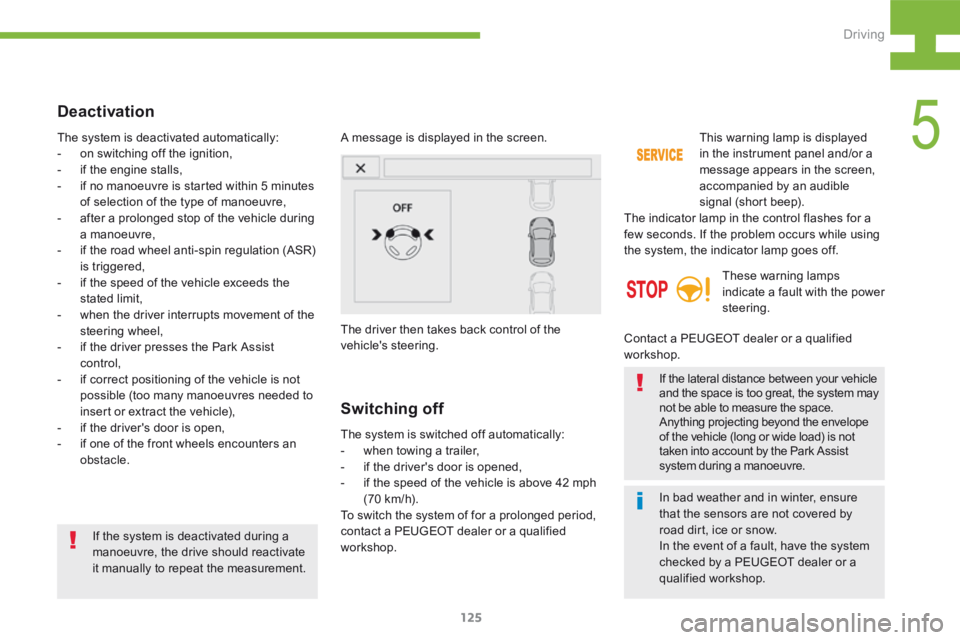
125
208_en_Chap05_conduite_ed01-2015
In bad weather and in winter, ensure
that the sensors are not covered by
road dirt, ice or snow.
In the event of a fault, have the system
checked by a PEUGEOT dealer or a
qualified workshop.
If the system is deactivated during a
manoeuvre, the drive should reactivate
it manually to repeat the measurement. If the lateral distance between your vehicle
and the space is too great, the system may
not be able to measure the space.
Anything projecting beyond the envelope
of the vehicle (long or wide load) is not
taken into account by the Park Assist
system during a manoeuvre.
Deactivation
A message is displayed in the screen.
The driver then takes back control of the
vehicle's steering.
The system is deactivated automatically:
-
on switching off the ignition,
- if the engine stalls,
- if no manoeuvre is started within 5 minutes
of selection of the type of manoeuvre,
- after a prolonged stop of the vehicle during
a manoeuvre,
- if the road wheel anti-spin regulation (ASR)
is triggered,
- if the speed of the vehicle exceeds the
stated limit,
- when the driver interrupts movement of the
steering wheel,
- if the driver presses the Park Assist
control,
- if correct positioning of the vehicle is not
possible (too many manoeuvres needed to
insert or extract the vehicle),
- if the driver's door is open,
- if one of the front wheels encounters an
obstacle.
Switching off
The system is switched off automatically:
- when towing a trailer,
- if the driver's door is opened,
- if the speed of the vehicle is above 42 mph
(70 km/h).
To switch the system of for a prolonged period,
contact a PEUGEOT dealer or a qualified
workshop. This warning lamp is displayed
in the instrument panel and/or a
message appears in the screen,
accompanied by an audible
signal (short beep).
The indicator lamp in the control flashes for a
few seconds. If the problem occurs while using
the system, the indicator lamp goes off.
These warning lamps
indicate a fault with the power
steering.
Contact a PEUGEOT dealer or a qualified
workshop.
5
Driving
Page 137 of 341
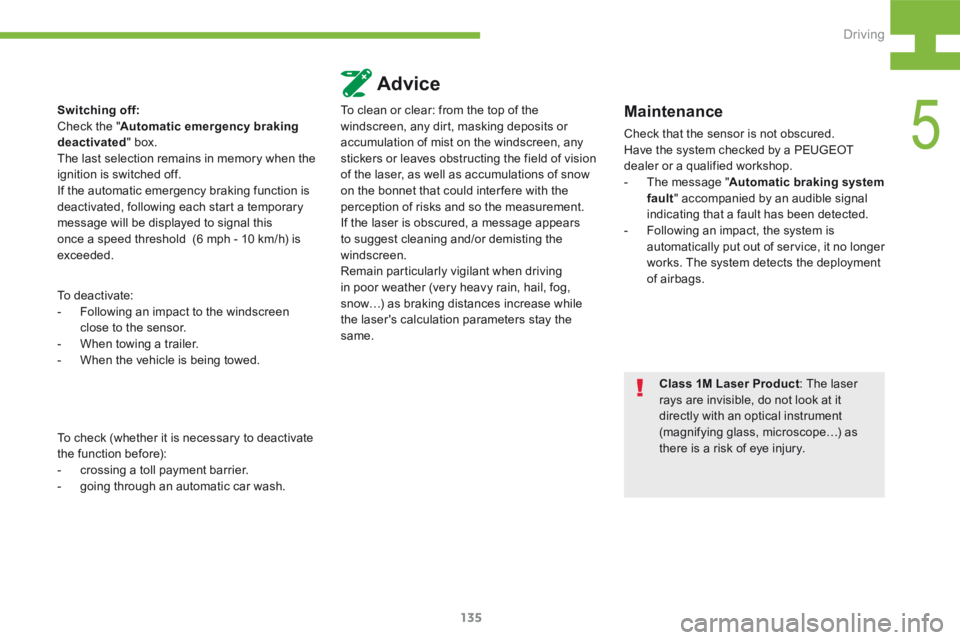
135
208_en_Chap05_conduite_ed01-2015
Switching off:
Check the "Automatic emergency braking
deactivated " box.
The last selection remains in memory when the
ignition is switched off.
If the automatic emergency braking function is
deactivated, following each start a temporary
message will be displayed to signal this
once a speed threshold (6 mph - 10 km/h) is
exceeded.
To deactivate:
- Following an impact to the windscreen
close to the sensor.
- When towing a trailer.
- When the vehicle is being towed.
To check (whether it is necessary to deactivate
the function before):
- crossing a toll payment barrier.
- going through an automatic car wash.
Advice
To clean or clear: from the top of the
windscreen, any dirt, masking deposits or
accumulation of mist on the windscreen, any
stickers or leaves obstructing the field of vision
of the laser, as well as accumulations of snow
on the bonnet that could inter fere with the
perception of risks and so the measurement.
If the laser is obscured, a message appears
to suggest cleaning and/or demisting the
windscreen.
Remain particularly vigilant when driving
in poor weather (very heavy rain, hail, fog,
snow…) as braking distances increase while
the laser's calculation parameters stay the
same.Maintenance
Check that the sensor is not obscured.
Have the system checked by a PEUGEOT
dealer or a qualified workshop.
- The message " Automatic braking system
fault " accompanied by an audible signal
indicating that a fault has been detected.
- Following an impact, the system is
automatically put out of service, it no longer
works. The system detects the deployment
of airbags.
Class 1M Laser Product : The laser
rays are invisible, do not look at it
directly with an optical instrument
(magnifying glass, microscope…) as
there is a risk of eye injury.
5
Driving